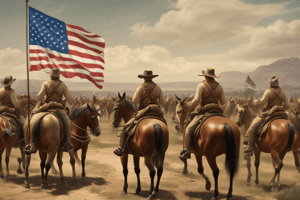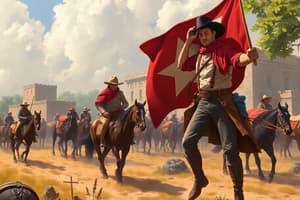Podcast
Questions and Answers
Who led the Texan forces to victory at the Battle of San Jacinto?
Who led the Texan forces to victory at the Battle of San Jacinto?
- Davy Crockett
- Jim Bowie
- Sam Houston (correct)
- Santa Anna
When did Texas become an independent republic?
When did Texas become an independent republic?
- March 6, 1836
- February 23, 1836
- April 21, 1836
- March 2, 1836 (correct)
What marked a turning point in the westward expansion of the United States?
What marked a turning point in the westward expansion of the United States?
- The Battle of San Jacinto
- The Battle of the Alamo
- The Mexican-American War
- Texas's independence (correct)
Who captured Santa Anna at the Battle of San Jacinto?
Who captured Santa Anna at the Battle of San Jacinto?
What event eventually led to Texas being annexed by the United States?
What event eventually led to Texas being annexed by the United States?
Who was the Mexican president during the Texas Revolution?
Who was the Mexican president during the Texas Revolution?
What land grant system allowed American immigrants to settle in Texas in the 1820s?
What land grant system allowed American immigrants to settle in Texas in the 1820s?
Who were some of the key figures who led the revolutionaries during the Texas Revolution?
Who were some of the key figures who led the revolutionaries during the Texas Revolution?
Why did tensions arise between Texas settlers and Mexican rule?
Why did tensions arise between Texas settlers and Mexican rule?
What key event accelerated California's transition to U.S. statehood?
What key event accelerated California's transition to U.S. statehood?
Which belief influenced the U.S. annexation of Texas and the acquisition of vast territories post-Mexican-American War?
Which belief influenced the U.S. annexation of Texas and the acquisition of vast territories post-Mexican-American War?
Which war resulted in the Mexican Cession and the U.S. acquiring territories like California and New Mexico?
Which war resulted in the Mexican Cession and the U.S. acquiring territories like California and New Mexico?
Who served as the U.S. President during the Mexican-American War?
Who served as the U.S. President during the Mexican-American War?
What significant event ignited the California Gold Rush in 1848?
What significant event ignited the California Gold Rush in 1848?
What event sparked a violent conflict resulting in the Texas Revolution?
What event sparked a violent conflict resulting in the Texas Revolution?
Which war led to the U.S. gaining California, Nevada, and parts of Colorado, Wyoming, and New Mexico?
Which war led to the U.S. gaining California, Nevada, and parts of Colorado, Wyoming, and New Mexico?
What legislation offered 160-acre land plots to encourage settlement in the western regions of the country?
What legislation offered 160-acre land plots to encourage settlement in the western regions of the country?
Which concept played a significant role in driving the expansionist policies of President James K. Polk?
Which concept played a significant role in driving the expansionist policies of President James K. Polk?
What historical phenomenon contributed to shaping the national identity of the United States through westward expansion?
What historical phenomenon contributed to shaping the national identity of the United States through westward expansion?
Flashcards are hidden until you start studying
Study Notes
Western Expansion: Texas Independence
In the grand tapestry of American history, the story of Texas's bid for independence stands as a significant chapter in the westward expansion narrative. This groundbreaking moment not only altered the course of the Lone Star State but also redefined the nation's boundaries and the future of the United States.
The Prelude to Independence
Texas's journey to freedom began in the early 19th century, as Mexican colonists, American settlers, and European immigrants began to populate its lands. The newly independent Mexican nation, under the rule of President Antonio López de Santa Anna, had vested interests in the region for several reasons, including the Texas territory's natural resources and strategic location on the Gulf Coast.
In the 1820s, Mexico extended a land grant called the "Empresario System," allowing American immigrants to settle in Texas, promising them land ownership in exchange for bringing new settlers. However, tensions arose as Texas settlers resented Mexican rule and sought greater autonomy.
The Texas Revolution
By the 1830s, Mexican rule and the centralist government under Santa Anna's leadership provoked a widespread revolt in Texas. The revolutionaries, led by figures such as Stephen F. Austin, Sam Houston, and James Bowie, proclaimed the Texas Declaration of Independence on March 2, 1836.
The Battle of the Alamo, one of the most famous engagements of the war, took place during the siege of the Alamo Mission in San Antonio from February 23 to March 6, 1836. The Mexican army, led by Santa Anna, overpowered the Texan defenders, who included such legendary figures as Davy Crockett and Jim Bowie. However, the Alamo's defenders, despite their defeat, inspired Texans to fight on.
The Texas Revolution reached its climax at the Battle of San Jacinto on April 21, 1836. Texan forces, led by General Sam Houston, decisively defeated the Mexican army under Santa Anna, capturing him and forcing Mexico to recognize Texas's independence.
The Republic of Texas
With Mexican rule overthrown, Texas became an independent republic on March 2, 1836, with Sam Houston as its first president. The new nation struggled to establish itself and attract settlers, but its government faced challenges such as maintaining peace with neighboring Indian tribes and resolving conflicts with the United States over Texas's boundaries and annexation.
The United States, after the Mexican-American War (1846-1848), eventually recognized Texas's independence and annexed it as part of the United States in 1845. Texas's independence marked a turning point in the westward expansion of the United States and the emergence of the Lone Star State as a powerful force in American history.
Texas's struggle for freedom serves as a reminder of the complexities and challenges faced during the westward expansion of the United States. The Lone Star State's independence paved the way for Texas to become a major player in American history, as well as a symbol of the nation's drive to spread its influence and shape the continent's destiny.
Studying That Suits You
Use AI to generate personalized quizzes and flashcards to suit your learning preferences.




